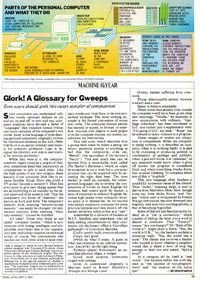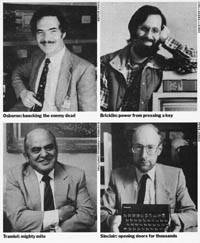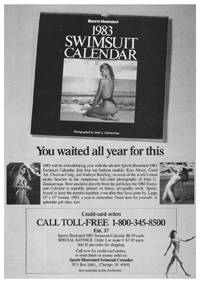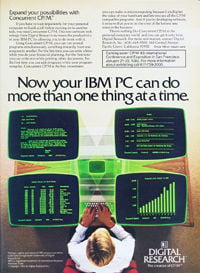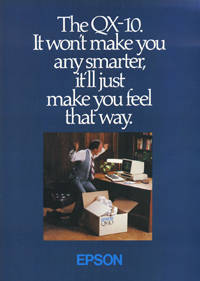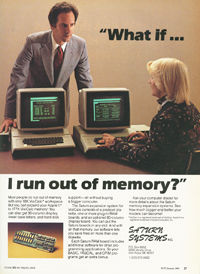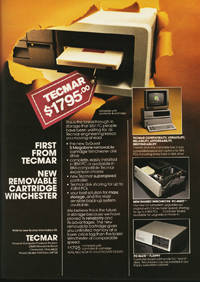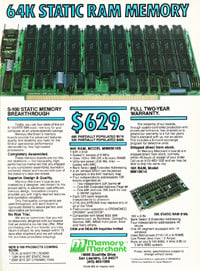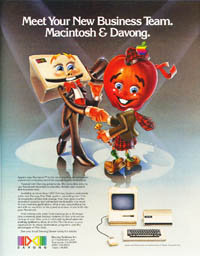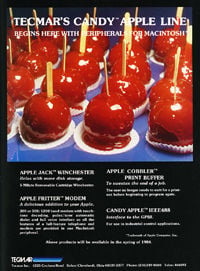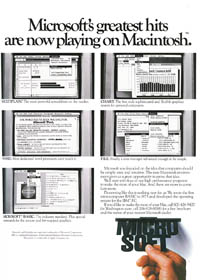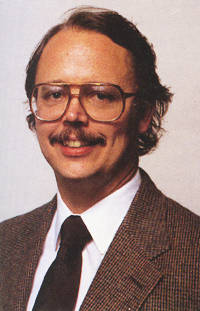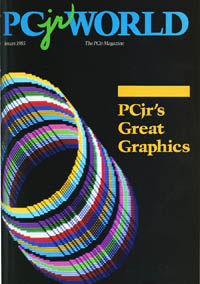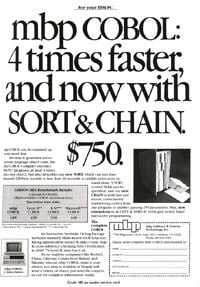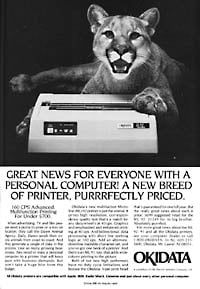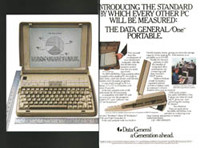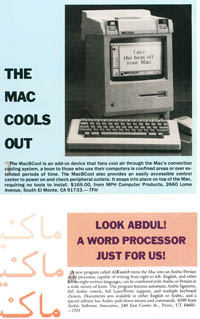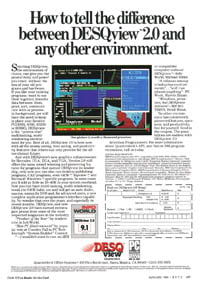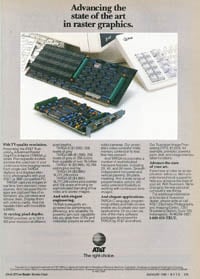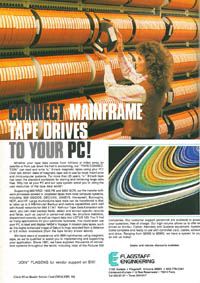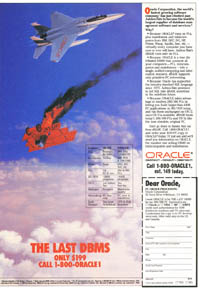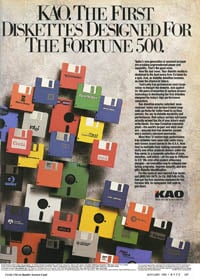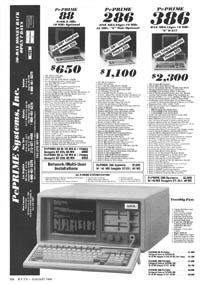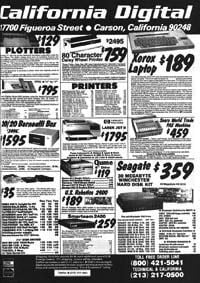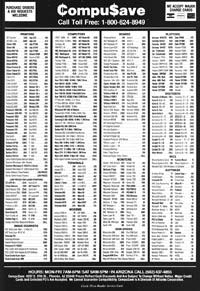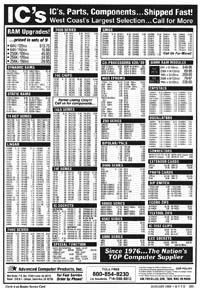Original URL: https://www.theregister.com/2012/11/23/early_days_of_pcs/
The early days of PCs as seen through DEAD TREES
The golden days of computer mags, replete with ancient adverts
Posted in Legal, 23rd November 2012 18:22 GMT
Feature Thirty years ago, Time Magazine broke its 86-year tradition of naming a Man of the Year, and instead anointed its first Machine of the Year: The Computer.
Time didn't deliver this news via www.time.com nor an HTML-encrusted email blast, but rather by macerated wood pulp pressed into sheets and coated with ink, cut into rectangles and stapled together, then arduously trucked, hauled, or flown to subscribers and newsstands.
Magazines, that is: one of 1983's prime communications vehicles.
Time's January 3, 1983 issue actually bestowed its annual honor not broadly on The Computer per se, but rather on the personal computer, the device we all now use as part of our workaday world, but back then was the mysterious "television typewriter" that was only beginning to come into its own.
As the premier US weekly news magazine's awardee, the personal computer was in exalted company: Time had previously awarded its annual honor to figures as diverse as Adolf Hitler and Lech Wałęsa, raising onto its editorial pedestal not necessarily the most admirable personage of the previous year, but the one who had most changed history.
In hindsight, it's easy to argue that although the PC has clearly not been as horrifically history-changing as Herr Hitler, it has however done far more to influence world affairs than Pan Wałęsa – and I write that as a proud descendant of the Polish working class that Wałęsa served so admirably.
It may be hard – or impossible if you're under 50 – to remember the days when PCs were just barely breaking into the mainstream. You may find it even harder to remember the influence that magazines had in that pre-internet, pre–"Let a Squillion Online Publications Bloom" era.
Time mattered. Its editorial decisions mattered. And mattering – along with, frankly, nattering – wasn't limited to mass-market news rags such as Time. When Time declared the PC to be Machine of the Year, computer magazines also mattered, nattered, and flourished, hauling in advertising hand over fist, ordaining winning products, and damning losers into the discount bins of the swap meets of yesteryear.
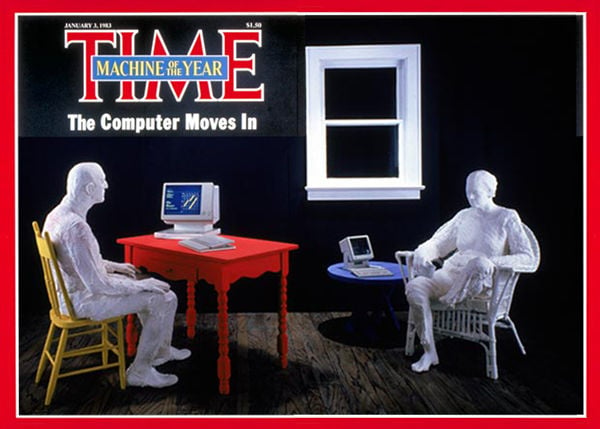
Time's 1983 gatefold cover: sculptor George Segal didn't present the cheeriest vision of a personal-computer future
It was a heady time. In the years following Time's award, the PC's fortunes waxed and computer magazines' fortunes waned. Some of you Reg readers may remember those days; most won't. But I wager that all of you might enjoy a wee bit of a jaunt back in time to revisit how magazines covered the PC's early days – and, sadly, how most of those rags either died out or faded into shadows of their former selves.
And so, hoping to both amuse and instruct, I ensconced myself in the main branch of the San Francisco Public Library, requested a stack of volumes to be pulled out of lonely storage, thumbed through them while decades of dust fouled my respiratory system, scanned and heavily Photoshopped selected pages, and slapped together the following.
Enjoy. And don't forget to click on the thumbnail images on the left of each page. Many have some great reading or admirable images – and marvelous hairstyles – that will either remind you of where you've been or explain the era during which those IT dinos around you cut their teeth.
Next Page: The Computer Moves In
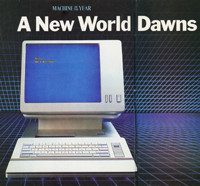
Time; January 3, 1983: The opening art
of Time's multi-story special report,
which tried to answer the question,
'What are these television-typewriter
things, anyway?' (click to enlarge)
Time; January 3, 1983: Can you grok this
cuspy frobnitz for gweeps?
(click to enlarge)
Time; January 3, 1983: Four personal-
computing pioneers. Hmm ... can you
guess which one is the coder?
(click to enlarge)
Time; January 3, 1983: This ad proves
that some traditions still endure. Oh, and
know that 1983's swimsuit sex bomb,
Kim Alexis, is now 52 years old
(click to enlarge)
The Computer Moves In
The personal computer, as any true geek knows, wasn't born in 1982, the year of which Time speaks when it refers to The Machine of the Year.
It's impossible to pinpoint exactly which device first moved computers from the enterprise mainframe's glass cage to the average desktop, but there's a consensus agreement that the personal computer movement kicked off when the MITS Altair 8800 was featured on the cover of Popular Electronics in January 1975. Your mileage opinion may vary.
In any case, the Altair's appearance was a full eight years before the personal computer moved from its hobbyist ham-radio-operator-turned-chiphead infancy into the budding society-changer that Time celebrated in its January 3, 1983, issue – although their editors didn't seem wholly convinced:
Time; January 3, 1983 editorial by John Meyers: Says Senior Writer Frederic Golden, "Computers were once regarded as distant, ominous abstractions, like Big Brother. In 1982 they truly became personalized, brought down to scale, so that people could hold, prod and play with them."For all that computers have achieved, they can still prove frustrating. In April, Golden's machine inexplicably swallowed the cover story he had written on the Computer Generation.Meanwhile, Senior Writer Otto Friedrich resolutely tapped out his Machine of the Year story on his favorite machine of all: a 15-year-old Royal 440.
Clearly, not all Time editors had not yet embraced the future. The magazine's main coverage, however, was more optimistic – although they did point out that there were still more than a few holdouts. Ah, those damnable buggy-whip manufacturers...
Time; January 3, 1983 "The Computer Moves In: By the millions, it's beeping its way into offices, schools and homes" by Jay Cocks: ... the enduring American love affairs with the automobile and the television are now being transformed into a giddy passion for the personal computer.A new poll ... indicates that nearly 80 per cent of Americans expect that in the fairly near future, home computers will be as commonplace as television sets or dishwashers.Estimates for the number of personal computers in use by the end of the century run as high as 80 million.... about 10 per cent of the typewriters in the 500 largest industrial corporations have so far been replaced.Some senior officials resist using a keyboard on the ground that such work is demeaning. Two executives in a large firm reportedly refuse to read any computer print-out until their secretaries have retyped it into the form of a standard memo.In the race among machines priced between $1,000 and $5,000, Apple still commands 26 per cent, followed by IBM (17 per cent) and Tandy/Radio Shack (10 per cent). But IBM, which has dominated the mainframe computer markets for decades, is coming on strong.
In addition to theorizing about the future of personal computing, Time's writers also took a moment to report on the current state of the personal-computing market. After talking about the low end – Commodore, Sinclair, Osborne, and the like - they discussed $5,000-and-up "personal work stations".
Time; January 3, 1983 "The Hottest-Selling Hardware" by Phillip Fatlick: Apple is joining the [professional work stations] crowd with its long-awaited Apple IV (code-named Lisa), due to be unveiled in mid-January. Lisa's probable price range: somewhere between $7,000 and $10,000. The Apple V (code-named Mackintosh [sic]), on the other hand, due out in mid-1983 and priced around $2,000, could be a true mass-market machine.
To step out of the computer world for a moment, and to prove the old adage of plus ça change, plus c'est la même chose, here's a letter to the editor from Time's "The Computer Moves In" issue:
Time; January 3, 1983 letter to the editor from Flinn Hudson: Gay families should receive the same rights as those allowed to traditional families. Since gays are among the taxpayers and consumers who pay for such benefit, they should have a share in them.
To paraphrase an ad campaign popular during those years, we haven't come all that long a way, have we, baby?
Next Page: In Byte, the discussion was deeper – much deeper
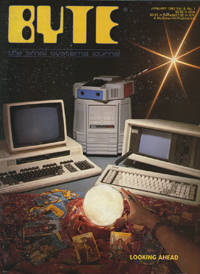
Byte, January 1983: The Heath HERO-1
'microcomputer-controlled robot' shared
a cover with Compaq's loveable luggable
and Epson's QX-10 Valdocs System
(click to enlarge)
Byte, January 1983: 'Using Concurrent
CP/M, you can run several programs
simultaneously, switching instantly
from one program to another'
(click to enlarge)
Byte, January 1983: In the early days of
personal computing, everyone got into
the act – even Epson, which bought an
eight-page, thick 'n' glossy–stock ad
to flog its QX-10 CP/M-or-DOS PC
(click to enlarge)
Byte, January 1983: 'Most people do run
out of memory with only 18K VisiCalc
workspace. But you can expand your
Apple II to 177K VisiCalc Memory!'
(click to enlarge)
Byte, January 1983: Tecmar thought
that the low, low price of $1,795
for its 5MB SyQuest–cartridge drive
was something worth shouting about
(click to enlarge)
Byte, January 1983: Thirty-two 150ns
16Kb SRAM chips add up to a capacious
64KB 'state of the art' S-100 board
that costs a mere $629 ($1,470 today)
(click to enlarge)
In Byte, the discussion was deeper – much deeper
While Time was a mass-market glossy that reported on the personal computing phenomenon only after said phenom had bubbled to the surface of the American consciousness, Byte: the small systems journal, on the other hand, was a phenomenon of its own, a deep-geek rag that had been published since September 1975, first appearing only eight months after Popular Electronics' January issue that had introduced the world to the Altair.
Before Time's adulatory PC article appeared, Byte – which focused on machines known in the argot of the day as microcomputers (or, to the French, micro-ordinateurs) – was the must-read rag for the personal computer geekerati. Not only did it carry the latest news of the latest products, it also published – unimaginable now in a broadly-selling publication – page after page of code and circuit diagrams.
And it was larded with advertising. Byte's January 1983 issue – the same month that Time proclaimed the personal computer as The Machine of the Year – was an astonishing 544 pages thick. By comparison, the next time you find yourself at a newsstand that still stocks one of the few remaining computer magazines, pick one up and check out its page count. Sad, isn't it?
Blame back-of-the-book ads, catalogs, the internet, and other factors – but more on that later.
A look at Byte's January 1983 issue – $2.95 in the US, £1.85 in the UK – illuminates how different the world of micro-ordinateurs is, here in the future, than it was in the pioneer past:
Byte, January 1983 "Review: The Compaq Computer" by Mark Dahmke: The Compaq computer is designed to be portable, and although it weighs 28 pounds, it achieves that goal.The Compaq's floppy-disk drives have major advantages, including 320KB of storage capacity each.An IBM PC with one double-sided drive (320K bytes), both the monochrome and color-graphics boards, a parallel-printer port, a monochrome monitor, and 128K bytes of RAM would cost approximately $3,735. All of these features are standard on the Compaq for $2,995.
The Compaq, by the way, was powered by a 16-bit Intel 8088, had a socket ready for the "future addition of Intel 8087 coprocessor," and 128KB of RAM expandable to 256KB. If you wanted to upgrade to a two-floppy system, that would run to $3,590, which in today's dollars would equal about $8,350.
In his editorial in that January 1983 issue, Byte's editor in chief Chris Morgan was ebullient about the personal-computer market that his mag had been following since its infancy. "The industry's new product fever rages on," he wrote, "spurred by record growth in sales and profits."
Morgan also demonstrated his optimism is an article about a then little-known – and, after that, still little-known – computer, the IBM 9000, powered by a Motorola 68000 microprocessor:
Byte, January 1983 "IBM's 'Secret Computer: The 9000" by Chris Morgan: The best-kept secret of 1982 may have been that IBM makes a 68000 computer. If that surprises you, you're not alone. The unit, called IBM Instrument Computer System, is IBM's second major microcomputer product – the first, of course, is the IBM Personal Computer.The IBM 9000 is ideally suited to the laboratory. But it strikes me that the 9000's processor board could become the heart of a general-purpose microcomputer for the business market. As I said earlier, IBM is not commenting on this speculation.I think the 9000 is, in its quiet way, one of the most exciting new arrivals on today's microcomputer scene. I predict it will start showing up in all sorts of unexpected places. In one gesture IBM has legitimized a microprocessor that deserves more attention: the Motorola 68000.
Morgan was right about the Motorola 68000 chip. The IBM 9000? Not so much.
Byte also spent seven pages ruminating on where processors might go in the future, fantasizing about new instruction sets and then-unheard of transistor counts:
Byte, January 1983 "The Next Generation of Microprocessor: A proposed inexpensive microprocessor that can directly execute a high-level language" by Timothy Stryker: It will not be long before integrated-circuit manufacturers begin to come out with single-chip processors that can directly execute high-level-language instructions. When that happens, the resulting explosion in the availability of high-speed, high-quality software could make the current stage of the computer revolution look like a halfhearted warm-up exercise by comparison....it is amusing to note that Electronics magazine once ran as part of a "New Year's Wish List" the fervent hope that Intel Corporation's Gordon Moore be granted "inspiration on what to do with a chip holding 1 million transistors." That wish may be granted yet.
In the same issue, Byte delved into a subject that was relatively new at the time in a 10-page article by an author whose name makes one wonder about his security-conscious desire for anonymity:
Byte, January 1983 "Public Key Cryptography: An introduction to a powerful cryptographic system for use on microcomputers" by John Smith: New kinds of cryptographic systems are emerging that have incredible properties, which appear to eliminate completely some problems that have plagued cryptography users for centuries. One of these systems is public key cryptography.
And when was the last time that a computer magazine spent 17 pages comparing coding prime-number discovery routines using the Sieve of Eratosthenes algorithm?
Byte, January 1983 "Eratosthenes Revisited: Once More through the Sieve: A closer look at a benchmark prime-number program and various Pascal and C compilers" by Jim Gilbreath and Gary Gilbreath: We're not knocking Pascal; its place in the world as a versatile and safe language is quite secure. But C was more fun to work with.
I rest my case: both computing and computing magazines were quite different 30 years ago, which leads us to the following January, when things started to change in a big, big way – something Byte prophesied in a February 1983 review of Apple's Lisa.
Byte, January 1983 Review: ... the Lisa is the most important development in computers in the last five years, easily beating IBM's introduction of the Personal Computer in August, 1981.Apple knows that this machine is expensive and is also not unaware that most people would be incredibly interested in a similar but less expensive machine. We'll see what happens...
Well, with hindsight being 20/20 and after 30 years of history, we all know what did happen.
Next Page: The Mac Moves In
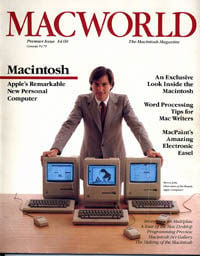
Macworld Premier Issue, February 1984:
Surely you recognize that jaunty
young fellow in the snazzy suit
(click to enlarge)
Macworld Premier Issue, February 1984:
As this ad for a 5-to-32MB Davong hard
drive shows, elegant design was not
a requirement in early third-party
branding efforts (click to enlarge)
Macworld Premier Issue, February 1984:
Apple Jack, Apple Fritter, Apple
Cobbler, Candy Apple; clearly, Tecmar
wanted to corner the market on bad-
apple puns. Bonus: a rare sighting
of an old-school reference to GPIB)
(click to enlarge)
Macworld Premier Issue, February 1984:
'MULTIPLAN: The most powerful spread-
sheet on the market. FILE: Finally,
a data manager advanced enough to
be simple' (click to enlarge)
PCWorld, January 1985: We're not trying
to pick on publisher David Bunnell,
but we just had to note the glasses he
was wearing in his editorial photo –
trés au courant, 1985-style
(click to enlarge)
PCWorld, January 1985: IBM was trying
to move computers into the home;
PCWorld added a 15-page section
to try to help. It didn't last long
(click to enlarge)
The Mac Moves In
On January 24, 1984, Apple introduced the Macintosh – or to use Apple's argot that eschews both definite or indefinite articles, Apple introduced Macintosh. Publishing house IDG, which had debuted PCWorld in March of the previous year, was prepared for the Mac's unveiling, and Macworld's Premier Issue hit newsstands in February.
Unlike Byte or even PCWorld, Macworld was decidedly less geeky than other computer magazines of the time – a reasonable editorial decision considering that the Mac was intended, as its advertising slogan suggested, to be "The Computer for the Rest of Us."
In his inaugural column, Macworld's editor-in-chief was positively effusive about the Mac and the brave new world it introduced:
Macworld Premier Issue, 1984 editorial by Andrew Fluegelman: Imagine how the fifteenth-century explorers felt as the first news from the recently discovered Western Hemisphere trickled back to Europe. That is the only analogy that approximates the excitement and wonder that I feel about the launching of the Macintosh computer.I confidently predict that the Mac will change forever our ideas about work and creativity – as well as the way we think about computers.
Despite his flowery rhetoric, Fluegelman was right – the Mac did change the relationship between users and their computers.
Macworld's teardown of the original Mac – yes, there were teardowns before iFixit came on the scene in 2003 – was equally positive, if a wee bit less flowery.
Macworld Premier Issue, 1984 hardware overview by Matthew Douglas: The Mac has been the subject of intense speculation in the past few months. The consensus was that Apple was about to win big or lose big. It's still too early to tell how the Apple marketeers will fare or what the competition will be, but one thing is clear: from a hardware viewpoint the Mac is truly a big win – rugged, fast, powerful, expandable, and affordable. A thoroughly marvelous design.The Mac is the most sophisticated computer ever offered in its price range and faster and more powerful than many machines that cost eight to ten times more.
By the way, for you trivia-contest geeks who confidently answer that the original Mac had a Motorola 68000 processor running a 8MHz, Macworld's Douglas would like to correct you: it actually ran at 7.8336MHz, he reported.
Microsoft's then-27-year-old Bill Gates also had kind words about a machine that he likely believed would increase his young company's revenue stream. He also inadvertently admitted that Microsoft had been overselling its own products.
Macworld Premier Issue, 1984 "Polishing the Mac" interview with Bill Gates: We've always promised people that they could simply buy a computer, turn it on, and use it. Even the Mac doesn't fulfill this promise, but it's a new milestone in terms of usability.The perfect machine will never exist, and the obvious difference between the perfect machine and the Mac is that you could ask for more memory, color, and a faster way to move data in and out of the machine. But when you look at price, you'll acknowledge that this machine is incredible.The Mac will be remembered as one of the great classic machines.
As might be guessed, Steve Jobs – who had famously flipped off the photographer who shot the cover photo for Macworld's Premier Issue – had good things to say in public about working on the development of the Mac and its importance to Apple.
Macworld Premier Issue, 1984 "The Making of the Macintosh", Steve Jobs: The Macintosh is the future of Apple Computer. For a very special moment, all of us have come together to make this new product. We feel this may be the best thing we've done with our lives.
Jobs was never much for understatement.
The following January, PCWorld's publisher reported on a subscriber survey which showed that even in the non-Mac world, the microcomputer was rapidly morphing into a personal computer that was not just for geeks, but for use in businesses and by professionals.
PCWorld January 1985 Editorial by David Bunnell: ... 90 per cent of PC World readers are employed as executive professionals and managers, 34.9 per cent hold postgraduate degrees, and ... 85 per cent of our readers own or use an IBM PC. ... 13.4 per cent own or use Compaqs, while only 3.8 per cent own or use Columbia-brand compatibles and 1.6 per cent own or use Eagles.
It was encouraging to note that the number of female subscribers (11.4 per cent) has almost doubled since last year's study.
Despite the gloomy predictions of the industry's economists, the personal computer market is obviously still going strong ... So much for the crash of '84.
Another indication that the PC was becoming more mainstream is the theme of PCWorld's January 1985 issue: "The Creative Side of Word Processing", which discussed how PCs were taking over from dedicated word-processing systems. The ease of document creation and modification, however, worried one contributor.
PCWorld January 1985 "New Dimensions in Word Processing" by Janette Martin: In an environment in which rewriting and editing are so facilitated by technology, the mark of an individual writer may well be diluted. Original creative efforts may largely be abandoned in favor of a new literature of compilation and collage.Advances to electronic word processing will continue to make rewriting as spontaneous and effortless as possible – and raise question we may not be able to answer so easily.
Speaking of questionable practices, personal investment-management was another use of the PC which was just getting started, years before the internet changed everything.
PCWorld January 1985 "Dialing for Dividends" by Michael Shapiro: ... now a new family of services currently in its infancy enables you to place orders from your home or office at any hour of the day or night.
Next Page: We magazine folk are here to help
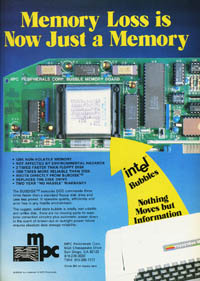
PCWorld, January 1985: Once promising,
soon gone. Farewell, non-volatile
bubble memory, we hardly knew ye
(click to enlarge)
PCWorld, January 1985: Yes, you could
run COBOL on your IBM PC and 'sort
four thousand 128-byte records in less
than 30 seconds' – but it'd cost you:
$750, or $1,750 in today's dollars
(click to enlarge)
PCWorld, January 1985: Okidata 9-pin
dot-matrix printers made a different-
pitched sound depending upon which
character it printed. I once wrote
a text file that played The Star
Spangled Banner. Sort of...
(click to enlarge)
PCWorld, January 1985: It may now seem
clunky, but the Data General/One was
a fine machine. Why? It was 'The only
portable with a full-size 80 column
by 25-line screen' (click to enlarge)
MacUser, January 1986: MacUser was
snarkier than Macworld; think The Reg,
not Cnet. In 1986, Macworld would
never begin an Arabic-software blurb
with 'Look Abdul!' (click to enlarge)
We magazine folk are here to help
As personal computing became increasingly mainstream, computer magazines continued to morph from places where the cognoscenti could converse amongst themselves about code snippets and big-picture industry trends into places where experts provided newbies with advice and recommendations.
Reviews became less technical, advice became more entry-level, and editors bestowed awards upon hardware and software – not necessarily to congratulate companies, but to provide buying advice to non-technical readers.
Newcomer MacUser, for example, used its January 1986 issue to inaugurate its "First Annual Software Awards", which in coming years expanded to include hardware and industry luminaries, as well.
MacUser January 1986 "The Envelope, Please..." by the MacUser editors: Best Overall Program of 1985: Excel from Microsoft for many, many reasons. Its spreadsheet routines are superb and totally outclass any spreadsheet running on any system. Couple the eye-widening graphics and charting capabilities to that spreadsheet and if your proposal doesn't carry the day at the board meeting you have no one to blame but yourself.Best Desktop Publisher: PageMaker from Aldus can make you into a futuristic Gütenberg of even a William Blake.Best Peripheral Device: ThunderScan from Thunderware is an astonishing device that transfers images to the Mac by scanning them using a snap-in device that replaces the ImageWriter ribbon.
Two MacUser columnists were equally effusive about one Apple hardware release and another Microsoft application (this was years before the term "app" was commonplace).
MacUser January 1986 "West Coast Report" by Michael Wesley: This is a momentous occasion, an announcement of incredible proportions. The hard disk is nice, but the price is phenomenal!I love Apple products but I've always hated Apple prices. Now, suddenly, Apple has brought out an important new product at a sensational price. Thank you, Apple. Really. A great big joyous thank you.MacUser January 1986 "A Man and His Macintosh" by Doug Clapp: Word is my life. I love Word. I understand it; it understands me. Friends may come and go; Word just gets better and better.
In 1987, PC Magazine was less purely enthusiastic than was MacUser, mixing adulation with brickbats.
PC Magazine January 1987 "The Best of 1986 (And Some of the Worst)", introduction by Bill Howard: In dramatic lore they were known as Famine, Pestilence, War, and Death. In 1986 their real names were the RT PC, the PC Convertible, the CMI hard disk, and the PC-XT Model 286. IBM continued to hold the biggest market share in 1986, but it was a shrinking share as others bested Big Blue on price, innovation, and bang for the buck. It didn't help that many of IBM's new entries were clunkers.Nineteen eighty-six brought more and faster PCs and ATs: Compaq's Deskro 386, which leads PCs into the 32-bit era; IBM's belated boost from 6 to 8 MHz on the AT; and a can't-tell-the-players-without-a-scorecard flood of PC and AT compatibles from just about every Japanese company that ever built a TV, VCR, stereo, printer, radar detector, or LCD wristwatch.
PC Magazine was quite enamoured with page after page of other products, including:
Compaq Deskro 386: The numbers are straightforward: 20 per cent more money and 100 per cent more processing speed than IBM's best AT. And that's with today's DOS and applications programs. When the operating systems and software catch up, speed gains may be tenfold.Lotus Development HAL: [This] "natural language interface" to 1-2-3 translates brief, conversational phrases into commands to enter formulas, move or copy data, build graphs, sort databases, and write macros. Sounds a bit like artificial intelligence? It is.Zenith Data Systems Z-181 Portable PC: If you like reading in the dark and typing on marshmallows, the other squinty, murky boxes might do. But if you need a road PC you can really use, don't even consider anything other than the Zenith Z-181.
Despite PC Magazine editor-in-chief Bill Howard's trashing of IBM in his awards-article intro, the bulldog psyche of that magazine just couldn't let go of Big Blue's pant leg.
PC Magazine January 1987 "Brickbats" by editors of PC Magazine: IBM Corp., for introducing the PC Convertible in April with a modem that didn't follow the Hayes command set – and then not delivering that modem till September. For a laptop PC, a fast, compatible modem is about as important as a good, legible screen, which, come to think of it, isn't so hot on the Convertible, either. R.I.P.
Next Page: Geek roots not forgotten
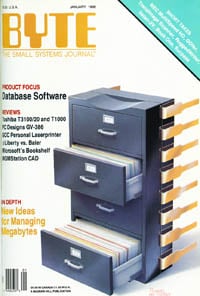
Byte, January 1988: Many of Robert
Tinney's Byte covers went on to become
collectors' items. Byte even picked up
a few bucks selling poster versions.
(click to enlarge)
Byte, January 1988: 'DESQview is the
"proven true" multitasking, multi-
windowing environment for you. Best
of all DESQview 2.0 is here now...'
(click to enlarge)
Byte, January 1988: Want 512-by-482,
24-bit color with an 8-bit alpha
channel? In 1988, you'd give AT&T
$4,995 – which would be $11,650 today.
(click to enlarge)
Byte, January 1988: 'Over 500 million
reels of magnetic tape are in use
by most mainframe and minicomputer
systems,' and Flagstaff wants to help
you read 'em. (Great hair, as well.)
(click to enlarge)
Byte, January 1988: 'Oracle
Corporation, the world's fastest-
growing software company, has just
climbed past Ashton-Tate to become
the world's larges supplier of
database management software and
services.' (cf. Virginia Slims, above)
(click to enlarge)
Byte, January 1988: Floppy disks, the
buggy whips of a new generation.
What's next to disappear from the PC
arena? Optical disks? x86 processors?
(click to enlarge)
Geek roots not forgotten
Even as computer magazines of the 1980s broadened their focus to a more general range of consumers who were using their PCs as business tools and home-entertainment fun-providers, they didn't abandon their more-technical audience. Even Mac mags found geeky things to write about.
MacUser January 1986 "Calling All ROMs" by Neil Shapiro: According to some people, writing programs for the Macintosh is similar to wearing a velvet, fashionably-cut straightjacket. No one, least of all yourself, will notice the restraints up until the time to flap your arms wildly about.I once heard a programmer refer to [Apple's UI guidelines] Inside Macintosh as Apple's version of Mein Kampf. He was only half joking.
MacUser also worked to keep its readers informed on the latest inner workings of their favorite computer company – such as one development that would have wide-ranging consequences.
MacUser January 1986 "West Coast Report" by Michael Wesley: It has been a quiet week in the West Coast. Steve Jobs resigned his position as Chairman of the Board of Apple Computer and announced his plans to form a new company to make computers for universities.At the time of this writing, there's no way to predict how the squabble between Mr. Jobs and Apple will be resolved.Whether the dispute will have any immediate or long-term impact on Macintosh is yet another question.
Even developers weren't forgotten in those days' mags – a group to whom consumer-level magazines rarely speak here in the 21st century. In addition to such articles as January 1986's "The Great Language Face-Off", featuring a comparison of BASIC, C, Pascal, and Forth, MacUser published how-to articles for devs.
MacUser January 1986 "Alpha-Beta Soup" by David Levy: David Levy, chess grandmaster and expert on computer games, shows how to program and use an Alpha-Beta search algorithm.
It may be hard for all but the most die-hard networking folks to remember at this point, but there was once an Ethernet competitor that received more than a little ink, such as the following article in PC Magazine.
PC Magazine January 1987 "The IBM Token-Ring Network" by Frank Derfler: The IBM Token-Ring Network is to networks what the Boeing 747 is to airplanes. It makes strange noises and requires special handling but can carry heavy loads. It offers power and flexibility but demands skilled management and control. It is one of the fastest things flying but not one of the prettiest.
Byte, as usual, was more focused on the hard-core computer user, even in its reviews. By 1988, you wouldn't expect to find a comparative roundup up SQL RDBMes in any other mag of the time – or, for that matter, find a review of a decidedly non-consumer device such as a portable Unix box.
Byte January 1988 "SQL Database Management Systems" by Richard Finkelstein and Fabian Pascal: Everybody seems to be talking about SQL (Structured Query Language) for relational database management systems (RDBMSes). But even though most major database suppliers have announced future support of SQL in their products, only a half-dozen database software packages for the IBM PC or XT currently claim to use SQL: Informix-SQL, Ingres for PCs, Oracle, SQLBase, XDB II, and XQL.>Byte January 1988 "The Symmetric 375: Symmetric's new system brings Berkeley Unix to a portable box" by Patrick Wood: The Symmetric 375 computer is a small, portable Berkeley Standard Distribution (BSD) 4.2 Unix system loaded with many useful features. Its small size (about that of Compaq Portable II) and weight (22 pounds) make it the only portable BSD Unix system I know of. The system reviewed here (which includes a bundled terminal and printer) is $8,995, but Symmetric discounts the price to $8,095 if it is prepaid.The Symmetric uses a National Semiconductor NS32016 processor running at 11MHz with no wait states and a 64-bit NS32081 floating-point processor.
Byte also ran more big-think pieces in those far-away days, although I may be speaking through my prejudice, being a devotee of that magazine – as if you couldn't already tell. For example, one 1988 article presages the arrival of an all-things-to-all-users global content access and sharing system: "Project Xanadu, The Original Hypertext Project". Think of it as an alpha-level internet.
Byte January 1988 "Managing Immense Storage" by Theodor H. Nelson: Project Xanadu is a system designed to be the principal publishing utility of the future. It will provide for the deposit, delivery, and continual revision of linked electronic documents, servicing hundreds of millions of simultaneous users with hypertext, graphics, audio, movies, and hypermedia.
Even when writing about such commonplace items as the ubiquitous floppy disk – as other magazines did at the time – Byte's reporting was more thorough than most.
Byte January 1988 "Price of Floppies Doesn't Guarantee Quality, Testers Say", news report: Despite wide variations in the cost and quality of floppy disks, there's no apparent relationship between the two, according to a company that has done a comparative study of 5 1/4-inch floppy disks.
But even though developers and hardware enthusiasts weren't forgotten during this transitionary period, advertisements began to appear that pointed toward a future that, although it included the geekerati, was clearly aimed at a broader market.
PC Magazine January 1987 "Interlude II" advertisement: Interlude II, the long-awaited sequel to the first adult computer game is finally here. It's provocative and playful! Outrageous and romantic!It probes your innermost desires to discern your mood of the moment, your secret longings, your special fantasies, then suggests for your pleasure one of its more than 160 Interludes.Interlude II will take you to the outer limits of fantasy and romance. And if the computer selects Interlude #99, your love life may never again be the same.
With the internet still years in the future, in 1987 soft-core smut was still delivered at the application level.
Next Page: The incredible shrinking magazine
Byte, January 1988: Even as late as
1988 – and beyond – the 'back of the
book' of computer magazines is where
you went to find ...
... systems (click to enlarge) ...
... peripherals (click to enlarge) ...
... bargains (click to enlarge) ...
... and even ICs (click to enlarge)
The incredible shrinking magazine
During the halcyon days of computer magazines, those "books" as they're called in the trade, were massive affairs, stuffed to the gills with adverts and editorial copy. As mentioned above, the same month that Time consecrated the personal computer as The Machine of the Year, Byte weighed in at 544 pages. That was no anomaly – the following month its page count was 538.
PC Magazine published two issues in January 1987 that totaled 718 pages. The more narrowly targeted MacUser topped out a couple of years later at 410 pages, and the behemoth Computer Shopper was so massive that New York postmen rebelled at having to deliver multiple copies to office blocks.
Things have changed. The current issue of Macworld is 114 pages and PCWorld has shrunk to a mere 104. But at least they still exist. Byte ceased dead-tree publication in July 1998 and PC Magazine, God rest its hard-copy soul, hung on all the way to January 2009 (both live on in online form, however).
Don't simply blame the internet. To be sure, the ability for publications to use inexpensive electrons rather than expensive atoms brought massive efficiency improvements, but there were other factors that tolled the death knell for chubby ad-filled magazines that delivered customers to advertisers.
Remember, mags don't earn all that much from newsstand sales – especially in the US – and subscribers are sought solely to put eyeballs in front of advertisers. Many of those advertisers eventually abandoned computer magazines.
One of the factors that led to that hasty departure can be found by picking up any computer magazine from the Machine of the Year era, and reading it from its final page. For dozens of pages you'll find ad after ad after ad in what was known as "the back of the book" – product-packed pages from mail-order vendors flogging their wares.
"BoB" was a marvelously inexpensive way for those vendors to get the word out about their low, low prices – but it couldn't last. After a vendor made a sale, they had in their possession the most valuable of marketing commodities: the customer's address.
When a vendor gathered enough addresses, it dropped out of BoB and published its own catalog on its own schedule, not bound by a magazine's calendar – or its advertising rate card. Catalogs were more efficient, and mail-order vendors that employed them sucked customers away from vendors still wallowing in BoB. Customers won, some vendors disappeared, and magazines suffered.
Another reason computer magazines faltered was the simple fact that reviews became less and less necessary; most products became quite reliable and their categories became commodified. As a product tester at MacUser in the 1980s, I remember a hard drive that caught fire and a CRT monitor that imploded, impressive product failures that are vanishingly rare these days. In those days, to twist an old saying, our job was to separate the wheat from the crap – and believe me, there was plenty of the latter.
More advertisers vaporized when vendor consolidation decimated the number of those either willing or able to pay for ad space. At MacUser I remember a well-tested comparison of 101 hard drives of 80 megabytes and up. Are there now enough major vendors to supply even a fraction of that number of different products? Nope.
Computer magazines also became less important to newbies. Compared with the early 1980s, computers became increasingly simple to use. Your average personal computer user turns his or her machine on and uses it, then shuts it down without an instant's thought about how it works, how it could be improved, or whether they could benefit from tips 'n' tricks to enhance its effectiveness.
"Good enough" won.
And then came the internet, and with it the one-two punch of email and the worldwide web. As more customers logged on, catalog-publishing mail-order vendors were presented with a trifecta of value: first, by moving their catalogs to the web, they could benefit from the aforementioned atoms-versus-electrons efficiencies; second, they could more nimbly change their prices, target specific geographies, and gain minute-by-minute control over their customer-facing operations.
And third is that all-important customer relationship. With targeted email, customer forums and support offerings, individualized offers, and so on, the fresh and vivacious internet seduced the fickle customer away from its old flame, the once-exciting but now rather dowdy computer rag.
Oh, and deep-pocket display-ad types? They no longer needed mags at all, now that they could better display their wares on their own websites, plus enjoy all the customer-relationship benefits of the mail-order folks. The big money walked.
Times change. And Time changed. In 1999, that magazine – still in good ol' print to this day, by the way – retired its Man of the Year title and replaced it with the more-inclusive Person of the Year. The first winner of that revised award was a man whose impact could not have been made without the roaring success of the personal computer: Amazon's Jeff Bezos.
The computer had moved in, indeed. ®
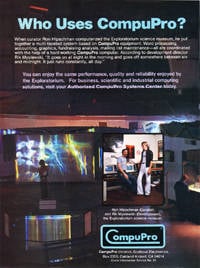
C/PM Computing (maybe), 1983 (or so):
This ad was shot at the Exploratorium
science museum in San Francisco in
the early 1980s, too long ago for me
to remember in what year or what
magazine it ran. (click to enlarge)
Bootnote
A few pages back I teased David Bunnell, then-publisher of PCWorld and Macworld, about his oh-so-80s glasses. Well, I lived through that period as well, and committed far more than my allotted share of egregious fashion faux pas.
Check out the skinny chap in the ad for CompuPro S-100 business systems to the right – the blonde in the white bell-bottoms and black Members Only jacket with the rolled-up sleeves. That's your Reg reporter at age 32. Or was it 33?
